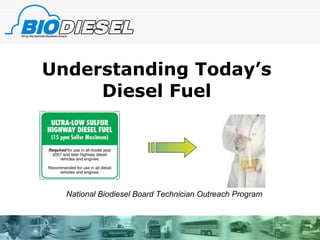
Diesel fuel properties
- 1. Understanding Today’s Diesel Fuel National Biodiesel Board Technician Outreach Program
- 5. Fuel technology Combustion technology Aftertreatment technology Fuel system technology Better understanding of combustion Alternate Fuels (Biodiesel) Low sulfur De-NOx DOC PM trap Rate control High pressure Multi-injection EGR technology Others Control technology Technology Pathway
- 9. Typical Refinery Products From: Schmidt, G.K. and Forster, E.J., “Modern Refining for Today’s Fuels and Lubricants,” SAE Paper 861176, 1986. Solid Petroleum Coke 1000 + 540 + Asphalt 650 - 1200 340 - 650 Residual Oil 650 - 1000 340 - 540 Lube Oils 350 - 650 180 - 340 #2 Diesel, Furnace Oil 340 - 515 170 - 270 Kerosene, Jet Fuel, #1 Diesel 80 - 400 30 - 200 Gasoline -40 - 31 -40 - 0 LPG Product Boiling Range Deg. F Boiling Range Deg. C
- 11. ASTM Specifications for Diesel Fuel -ASTM D 975
- 15. 3 PROPANE METHANOL ETHANOL 8 ISO OCTANE (GASOLINE) 20 CETANE (DIESEL FUEL) Benzene Toluene Xylene
- 16. Low Cetane Impact Poor Ignition Quality Long ignition delay Abnormal Combustion Possible High Combustion Pressure Increased Engine stress Excessive Engine Knock Smoke on Cold start
- 26. Flashpoint
Notes de l'éditeur
- Most of you have seen this slide, which discloses the various technologies that are being applied to achieve Tier 2-4 emissions levels. I will only discuss the fuel system where the migration to common rail systems are a key leverage for achieving low emissions.
- 1-D : A special-purpose, light middle distillate fuel for use in diesel engine applications with frequent and widely varying speeds and loads or when abnormally low operating temperatures are encountered. Higher volatility than that provided by No. 2-D fuels. 2-D A general-purpose, middle distillate fuel for use in diesel engines, especially in applications with relatively high loads and uniform speeds, or in diesel engines not requiring fuels having higher volatility or other properties specified in Grade No. 1-D fuels. 4-D A heavy distillate fuel, or a blend of distillate and residual oil, for low- and medium-speed diesel engines in applications involving predominantly constant speed and load.
- This slide gives the molecular structure of the some fuels, in addition the number of carbons. The comparison of the parent fuel structure to the alternative fuels is very important, as you’ll see later on in the presentation. You will see that methane has one carbon, surrounded by hydrogens; propane has three carbons. You see methanol as the alcohol over to the right with one carbon, and ethanol, as an alcohol with two carbons. Below those are Iso Octane, which has 8 carbons in a branched structure, which will become important. This makes an ideal gasoline and Iso Octane has an octane number of 100. Then you see an standard diesel fuel, cetane, which is a long straight chain molecule with no branching and 20 carbons. Cetane has a cetane number of 100. You can see that gasoline is a much shorter, and more branched compound, whereas diesel fuel is much longer and more straight chain hydrocarbon. You can also see some examples of aromatics. These compounds are known carcinogens in diesel fuel but are not present in biodiesel. The aromatics all share a similar 6 carbon ring, known as benzene.
- Low cetane number fuels are slow to ignite and then burn too rapidly, leading to high rates of pressure rise. These poor combustion characteristics can give rise to excessive engine noise and vibration, increased exhaust emissions and reduced vehicle performance, with increased engine stress specifically on the piston & cylinder
- ASTM D 2274 is most commonly referenced